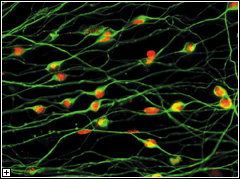





      |

The complexity of the fully formed brain defies description, yet this
organ arises from a nondescript clump of cells in the embryo. The specification of the dorsal-ventral axis is significant in neural
development in that the central nervous system forms on the dorsal side
of the body in all vertebrate orders. This process is dictated by the
effects of a number of signaling factors that diffuse from organizing
centers and direct dorsal ectoderm to maintain a neural fate. These molecules,
which include Noggin, Chordin, Follistatin and their homologs, participate
in elaborate signaling networks in which factors collaborate and compete
to initiate the embryonic nervous system.
The specification of the dorsal-ventral axis is significant in neural
development in that the central nervous system forms on the dorsal side
of the body in all vertebrate orders. This process is dictated by the
effects of a number of signaling factors that diffuse from organizing
centers and direct dorsal ectoderm to maintain a neural fate. These molecules,
which include Noggin, Chordin, Follistatin and their homologs, participate
in elaborate signaling networks in which factors collaborate and compete
to initiate the embryonic nervous system.
Using the African clawed frog, Xenopus laevis, as a model in molecular embryological studies, our group is engaged in clarifying the structure and extent of the signaling networks involved in settingup the dorsal-ventral axis and determining neural fate in the ectoderm. These studies focus on molecules that operate at early stages in embryonic development to lay downa complex of permissive, instructive and inhibitory patterns that determines the growth and differentiation of the brain in its earliest stages of development.
 Our
group is now also actively developing effective methods of inducing neuralization
in mammals, work which it is hoped will contribute to basic research by
providing in vitro experimental systems for use in the analysis of mammalian
neurogenesis. In addition, this approach has potential for application
in the treatment of neurodegenerative disorders, such as Parkinson disease.
Using a system developed in our lab, we have succeeded in inducing mouse
and primate embryonic stem (ES) cells to differentiate into a range of
specialized neuronal types. The application of similar techniques to human
ES cells represents a field of study that, although still at an early
stage, shows immense clinical promise.
Our
group is now also actively developing effective methods of inducing neuralization
in mammals, work which it is hoped will contribute to basic research by
providing in vitro experimental systems for use in the analysis of mammalian
neurogenesis. In addition, this approach has potential for application
in the treatment of neurodegenerative disorders, such as Parkinson disease.
Using a system developed in our lab, we have succeeded in inducing mouse
and primate embryonic stem (ES) cells to differentiate into a range of
specialized neuronal types. The application of similar techniques to human
ES cells represents a field of study that, although still at an early
stage, shows immense clinical promise.
By studying very early neurogenesis, and the mechanisms of neuronal differentiation, our lab aims to understand the molecular basis underpinning the formation of so intricate a system as the mammalian neural network, in the hopes that, by looking at the elegant simplicity of the embryonic brain, it may one day be possible to understand the cellular bases of the mind's activity.